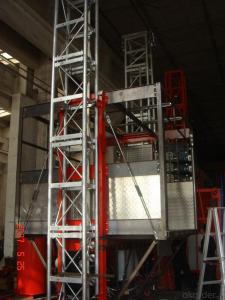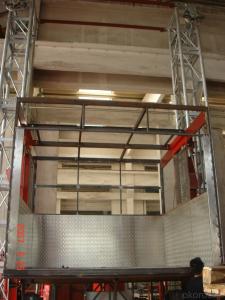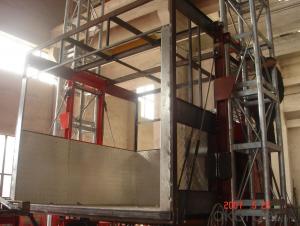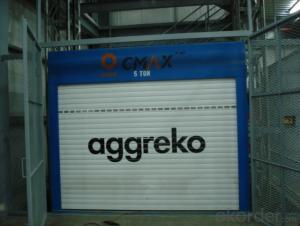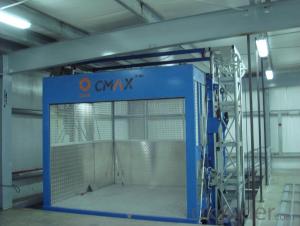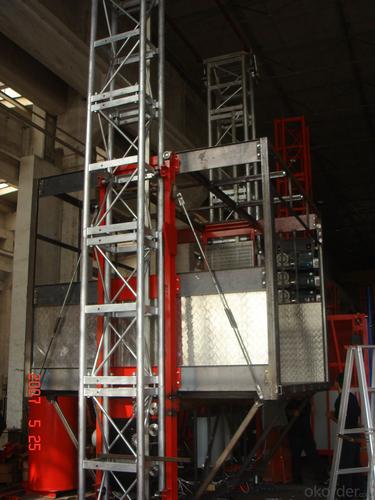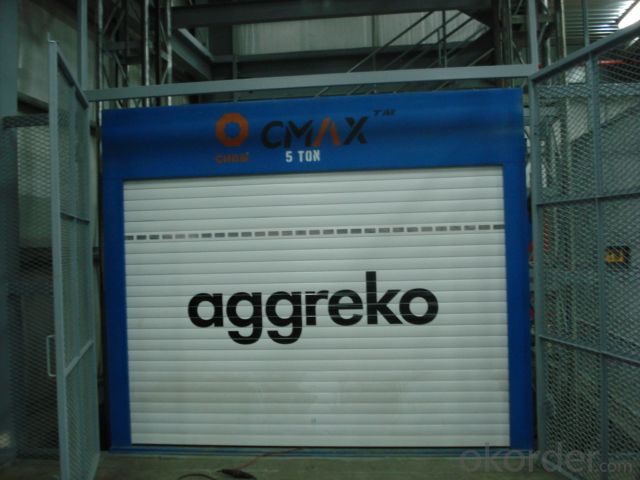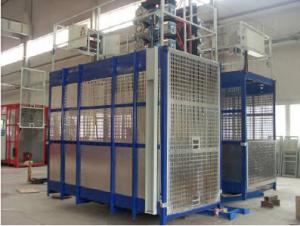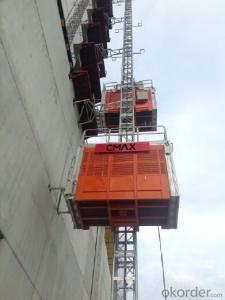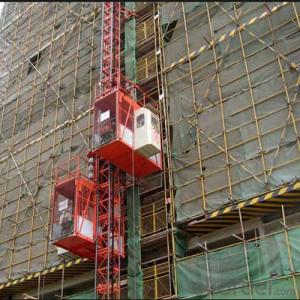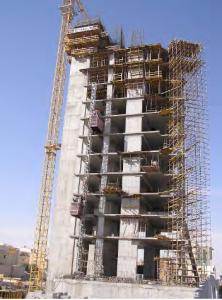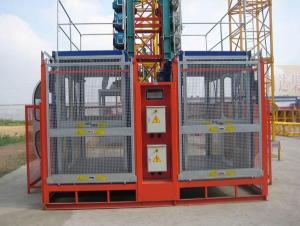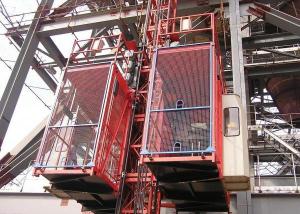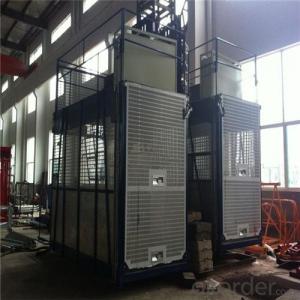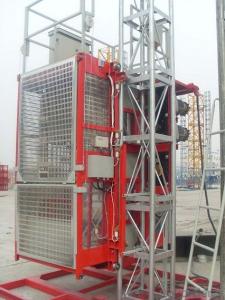Building Hoist SC120D with Special Software,More Safe and Reliable
- Loading Port:
- China main port
- Payment Terms:
- TT or LC
- Min Order Qty:
- 1 pc
- Supply Capability:
- 100 pc/month
OKorder Service Pledge
OKorder Financial Service
You Might Also Like
Description
The general building hoist manufactured by our company have the features as good quality, long life, wide application range and convenient for maintenance, the gering adopts imported bearing, enameled cable, and oil seal, the electric parts adopt products from world renowned manufactures such as Schneider, Siemens, and LG, the racks and pinion adopts special material and heat-treatment technique, which prolong the life of these parts. The steel structure uses quality steel from famous domestic manufacturers, the surface of the structure can apply paint-spray, Parkerizing baking finish or hot galvanizing processing according to users requirements, the cage can be produced and decorated by aluminum molded board, punched-plate or figured aluminum board.
Main Parts of Building Hoist
1. Adopts the most advanced VF speed control device and microcomputer programmable logic controller.
2. Stepless speed control helps eliminate the concussion during start up and braking, steady the operation process, and ensures automated leveling.
3. Adopts open loop V/Fcontrol; the speed control precision can reach ±2~3%. Realizes accurate low speed positioning of the hoist and avoid slipping during downward stopping of hoist.
4. The VF system has current-restriction function, ensuring a small current when motor start up and reducing the concussion to power supply. It reduces the engery consumption and mitigates effects to on site electric equipments.
5. The steadiness during running mitigates concussion to mechanical parts, reduces wears of rack, pinion and the brake and prolongs the spare parts'life.
6. The VF system also has the over voltage protection,low voltage protection, overcurrent, overload and anti-stalling protection functions,
7. The system applies the special software for hoists developed by our company, making the operation more safe and reliable.
Building Hoist images
CMAX Building Hoist
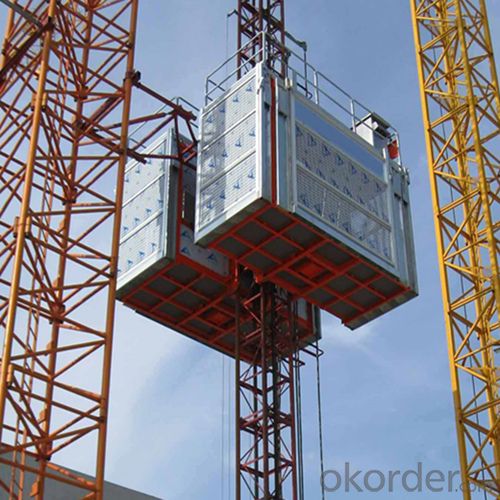
Anchorage System
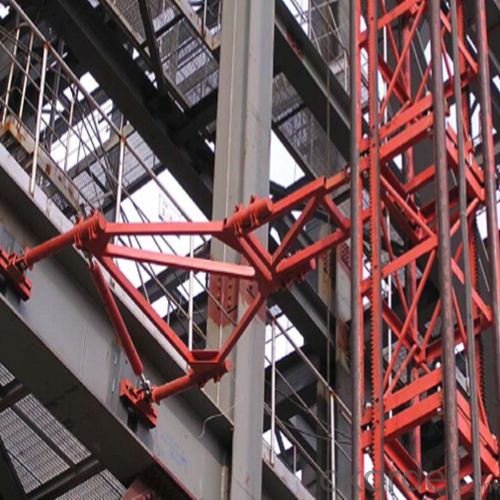
Driving Unit

Warehouse
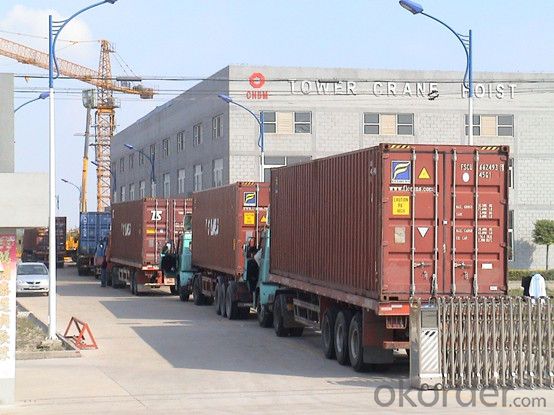
Building Hoist Specifiction
Main technical data | Unit | Value |
Rated load | kg | 1200 |
Rated erection load | kg | 1000 |
Jib attachment rated load | kg | 300 |
Cage size | m | 3.0×1.3×2.5 |
Maximum lifting height | m | 250 |
Lifting speed | m/min | 0~45 |
Rated output | kW | 2×16.5 |
Voltage rating | V | 380/440 |
Rated frequency | Hz | 50/60 |
Rated current | A | 2×34.4 |
Power supply fuses | A | 96 |
Protective class | / | IP55 |
Load duration factor | / | FC-25% |
Safety device | m/s | 1.2 |
Enclosure weight | kg | 980 |
Cage weight | kg | 1800 |
Counterweight | kg | / |
Mast section weight | kg | 125/145 |
Mast section length | mm | 1508 |
If you have special requirement on power, please state it when order the consignment.
We can produce the cage and lengthen the tie-in according to the size the customer requested.
We can heighten the erection height according to the customer’s request.
“/” means the item does not exist.
FAQ of Building Hoist
Q: What is the building hoist main purpose?
A: Building hoist equipped with double or single cabin to transport the materials and labors up and down. It's the ideal construction equipment for vertical transportation in the field of construction.
Q: What is the main structure of building hoist?
A: The P/M construction hoist mainly contains metal structure, driving system, electrical control system, cable guide & protection system, electrical top crane and safety device.
Q: What is the meaning of the building hoist’s code?
A: Take SC200/200 for example: “SC” stands for rack and pinion hoist, “200/200” stands for double cage and capacity is 2 tons per cage. “SC200” stands for single cage and capacity is 2 tons.
Q: What is the dimension of the cage?
A: Normally the cage dimension is 3X1.5X2.5M (L/W/H) for 2t type hoist. Details should be checked according to our quotation sheet. Also, the size can be customized according to the factual site condition. There are two doors (entrance & exit doors) for each cage, It can be produced as up & down sliding or ramping model for safety and convenience.
- Q: Why is the construction elevator not up to the roof
- The free end of the construction of the lift height is only 7.5 meters high, general construction elevator drive now is the case, so the hoisting cage height and drive around 4.5 meters high, the other national standard construction elevator ceiling limit moves, drive above about 1.8 meters away from the top of the rails. So it's the free end of the construction elevator that can't satisfy the roof. As long as they can set up effective adhesion measures, they can also get on the roof.
- Q: Is it possible for a building hoist to simultaneously lift and lower various materials?
- <p>Yes, a building hoist can be used to raise and lower different materials at the same time, provided it has the necessary capacity and the materials are properly secured. This is often done by using multiple hooks or platforms, each designated for different materials. It's crucial to ensure that the combined weight does not exceed the hoist's load limit and that safety protocols are strictly followed to prevent accidents.</p>
- Q: How many kw is the sc construction elevator
- The construction elevator sc200/200 is rated at 63 kw power, and the power consumption is greater.
- Q: This question asks for a list of various types of cables that are utilized in lifting equipment.
- <p>Lifting equipment employs several types of cables, each designed for specific purposes. The primary types include: 1. Wire ropes, which are the most common and are used for their strength and flexibility. 2. Chain slings, which are strong and durable but less flexible than wire ropes. 3. Synthetic slings, made from materials like nylon or polyester, offering lighter weight and resistance to chemicals. 4. Round slings, providing a smooth surface to protect loads from damage. 5. Wire rope slings, which are versatile and can be used in various configurations. 6. Aircraft cables, known for their high strength and resistance to corrosion. 7. Endless wire rope slings, which are used for heavy loads and offer a looped design. Each type of cable has its own set of advantages and is chosen based on the specific requirements of the lifting task.</p>
- Q: What is the height of protecting door protection of construction elevator
- Elevator protection door is strict according to the mandatory standard to set up elevator well protection measures for safety technology. The shaft must be set in the range of 1.5 to 1.8, with protective railings or fixed gate and protective railings or fixed doors. 2, elevator well in plus or minus zero layer need to set up the first safety net, every two layers, the upper part of most every 10 m AnQuanPing network design, network security quality must gb5725-1997 "safety net" of standard network, methods must be checked in accordance with the relevant provisions. Installation in the safety net elevator dismantlement, the operator should wear the seat belt according to the regulation. On the floor and roof, a short side hole is larger than 1.5 m, the hole should be set in the requirement of the protective railing, the bottom setting safety net. To set safety warning signs that meet national standards in the elevator shaft. Safety warning signs are clear, warning lights should be set at night. The protective railings and gates shall be marked with yellow and black stripes and shall be manufactured according to the standards of construction safety technical specifications. 5, elevator wellhead protection facilities need to dismantle or change temporarily, and by the project full-time safety sign shall be the responsibility of the project director, and ready to move or change the security countermeasures. To inform all staff at the same time; Recovery after safety facilities must be by the project director, full-time security personnel and other related personnel on-site inspection management, qualified rear can continue to use.
- Q: Is it possible to use two lifting devices simultaneously to lift an object that is heavier than the maximum weight each device can handle individually?
- <p>Yes, two lifting devices can be used together to lift a heavier object than either one can handle alone, provided that both devices are capable of supporting the combined weight and are properly synchronized. This requires careful planning and coordination to ensure the safety of the operation and the integrity of the lifting devices. The total weight capacity of the combined system should be greater than the weight of the object being lifted, and the devices must be designed to work in tandem without overloading or causing damage.</p>
- Q: What are the steps and considerations for maintaining a building hoist to ensure its safety and functionality?
- <p>To maintain a building hoist properly, follow these steps: Regularly inspect the hoist for any visible damage or wear. Lubricate moving parts as per manufacturer's recommendations. Ensure all safety devices are functioning correctly, including limit switches and emergency stop buttons. Check the hoist's electrical system for any signs of damage or wear. Keep the hoist clean and free from debris. Conduct a thorough inspection after any incident or near miss. Regularly test the hoist's load capacity to ensure it is within safe limits. Train operators on safe hoist operation and maintenance procedures. Always follow the manufacturer's guidelines and local regulations for maintenance and inspection.</p>
- Q: For example, what records do you want to have a third party monitoring?
- After the construction elevator overhaul, the contents of the inspection and acceptance inspection shall be inspected; In the use of elevators, the contents of the regular inspection shall be conducted once a year in accordance with the provisions of the regulations.
- Q: Is it possible to substitute a hydraulic cylinder for an electric motor in a building hoist system?
- <p>A hydraulic cylinder can indeed be used as a replacement for a motor in a building hoist, but it requires a different system design. Hydraulic systems use fluid pressure to generate linear motion, which can be harnessed to lift and lower loads. They offer high power-to-weight ratios and can handle heavy loads, making them suitable for hoisting applications. However, they require a power source for the hydraulic pump, and the system must be designed to manage fluid flow, pressure, and safety features. Unlike electric motors, hydraulic systems also need regular maintenance and can be less energy-efficient. Despite these differences, with proper design and engineering, a hydraulic cylinder can effectively replace an electric motor in a hoist system.</p>
- Q: What are the fundamental parts that make up a building hoist?
- <p>The basic components of a building hoist include the hoist machine, mast or tower, guide rails, lifting cage, counterweight system, safety devices, electrical control system, and communication system. The hoist machine powers the lifting and lowering of the cage, while the mast provides structural support. Guide rails ensure the cage moves vertically, and the counterweight balances the cage's weight. Safety devices protect against accidents, and the electrical control system manages operations. The communication system allows for coordination between the hoist operator and other construction personnel.</p>
Send your message to us
Building Hoist SC120D with Special Software,More Safe and Reliable
- Loading Port:
- China main port
- Payment Terms:
- TT or LC
- Min Order Qty:
- 1 pc
- Supply Capability:
- 100 pc/month
OKorder Service Pledge
OKorder Financial Service
Similar products
Hot products
Hot Searches
Related keywords
